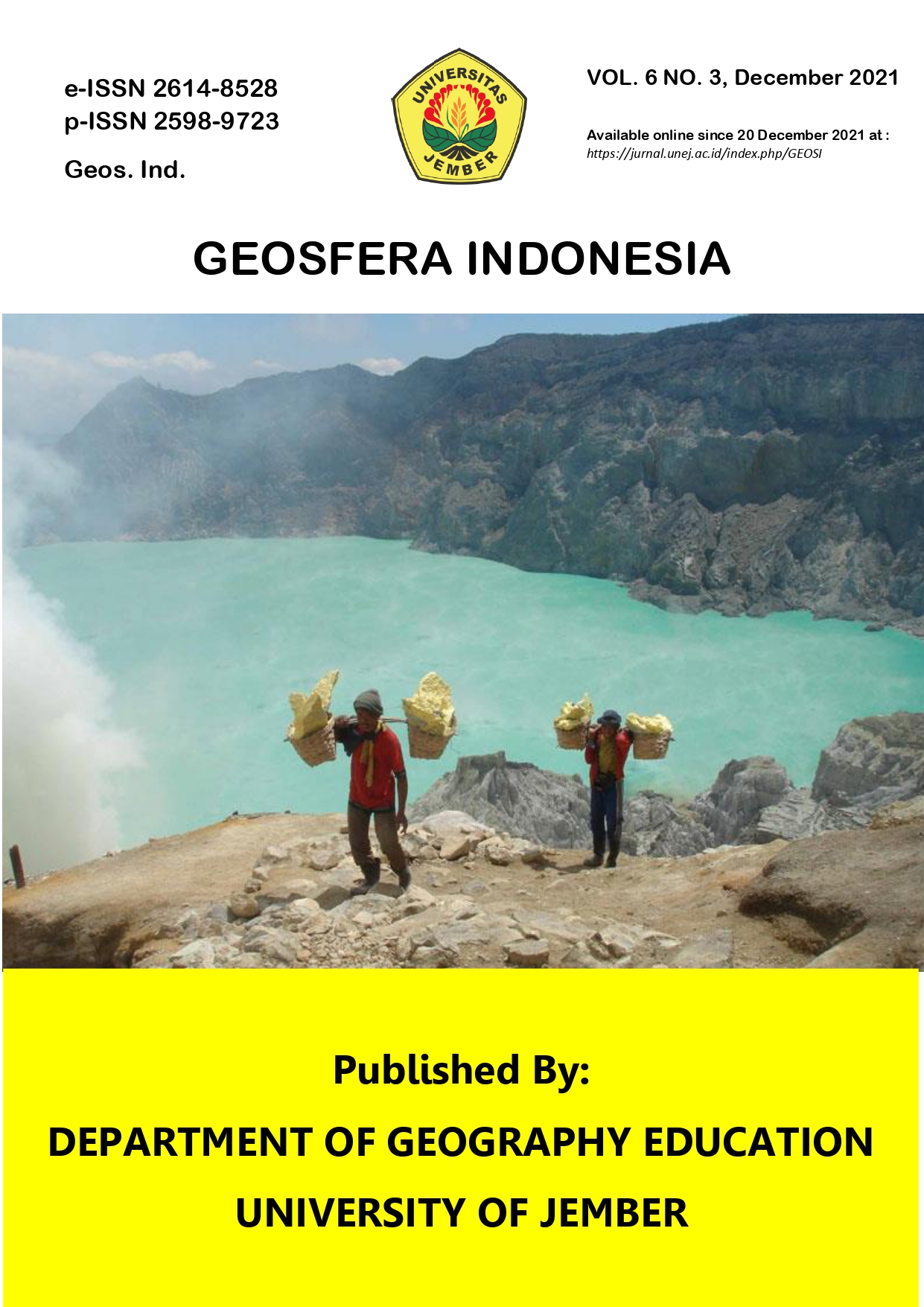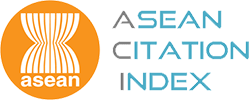Assessment of Coral Reef Life-Form Classification Scheme using Multiresolution Images on Parang Island, Indonesia
Abstract
Spatial information on the varying composition of coral reefs is beneficial for the management and preservation of natural resources in coastal areas. Its availability is inseparable from environmental management goals; however, it can also be used as a means of supporting tourism activities and predicting the emergence of certain living species. A satellite image is one of the effective and efficient data sources that provide spatial information on coral reef variations. This study aimed to evaluate the classification scheme of coral reef life-form using images with different spatial resolutions on Parang Island, Karimunjawa Islands, Central Java. These images were from PlanetScope (3m), PlanetScope resampling (6m), and Sentinel-2A MSI (10m), whose spatial resolutions functioned as the base for building the 3m, 6m, and 10m classification schemes producing 12, 11, and 9 classes, respectively. As for the classification method, it integrated both object-based and pixel-based approaches. The results showed that the highest overall accuracy (60%) was obtained using Sentinel-2A MSI image (10m), followed by PlanetScope (3m) with 48% accuracy, and PlanetScope resampling (6m) with 40% accuracy. This finding indicates that multiresolution images can be used to produce complex coral reef life-form maps with different levels of information details.
Keywords: Coral reef; Life-form; Planetscope; Spatial resolution; Classification scheme
Copyright (c) 2021 Geosfera Indonesia and Department of Geography Education, University of Jember

This work is licensed under a Creative Commons Attribution-Share A like 4.0 International License
References
Dudgeon, S., Aronson, R., Bruno, J., & Precht, W. (2010). Phase shifts and stable states on coral reefs. Marine Ecology Progress Series, 413, 201–216. https://doi/10.3354/meps08751.
English, S., Wilkinson, C., & Baker, V. (1994). Survey Manual for Tropical Marine Research. Townsville: ASEAN-Australia Marine Science Project. Canberra: Australian Institute of Marine Science.
Giyanto, Abrar, M., Hadi, T. A., Budiyanto, A., Hafizt, M., Salatalohy, A., & Iswari, M. Y. (2017). Status Terumbu Karang Indonesia. Jakarta: Pusat Penelitian Oseanografi - LIPI.
Goodman, J. A., Purkis, S. J., & Phinn, S. R. (2013). Coral Reef Remote Sensing: A Guide for Mapping, Monitoring and Management. New York: London: Springer.
Green, E. P., Mumby, P. J., Edwards, A. J., & Clark, C. D. (2000). Remote Sensing handbook for Tropical Coastal Management. Paris: UNESCO.
Hedley, J. D., Harborne, A. R., & Mumby, P. J. (2005). Technical note : Simple and robust removal of sun glint for mapping shallow-water benthos. International Journal of Remote Sensing, 26(10), 2107-2112. https://doi.org/10.1080/01431160500034086.
Hedley, J. D., Roelfsema, C., Brando, V., Giardino, C., Kutser, T., Phinn, S., … Koetz, B. (2018). Coral reef applications of Sentinel-2: Coverage, characteristics, bathymetry and benthic mapping with comparison to Landsat 8. Remote Sensing of Environment, 216, 598–614. https://doi.org/10.1016/j.rse.2018.07.014.
Hochberg, E. J., & Atkinson, M. J. (2000). Spectral discrimination of coral reef benthic communities. Coral Reefs, 19(2), 164-171. https://doi.org/10.1007/s003380000087.
Hoegh-Guldberg, O., Mumby, P. J., Hooten, A. J., Steneck, R. S., Greenfield, P., Gomez, E., ... & Hatziolos, M. E. (2007). Coral reefs under rapid climate change and ocean acidification. science, 318(5857),1737-1742. htpps://doi.org/10.1126/science.1152509.
Kay, S., Hedley, J. D., & Lavender, S. (2009). Sun glint correction of high and low spatial resolution images of aquatic scenes: A review of methods for visible and near-infrared wavelengths. Remote Sensing, 1(4), 697-730. https://doi.org/10.3390/rs1040697.
Larkum, A., Orth, R., & Duarte, C. (2006). Seagrasses: Biology, ecology and conservation. Dodrecht: Springer.
Lyzenga, D. R. (1978). Passive remote sensing techniques for mapping water depth and bottom features. Applied optics, 17(3), 379-383.
Lyzenga, D. R., Malinas, N. P., & Tanis, F. J. (2006). Multispectral bathymetry using a simple physically based algorithm. IEEE Transactions on Geoscience and Remote Sensing, 44(8), 2251-2259. https://doi.org/10.1109/TGRS.2006.872909.
Ma, L., Li, M., Ma, X., Cheng, L., Du, P., & Liu, Y. (2017). A review of supervised object-based land-cover image classification. ISPRS Journal of Photogrammetry and Remote Sensing, 130, 277-293. https://doi.org/10.1016/j.isprsjprs.2017.06.001.
Madduppa, H. H., Santoso, P., Subhan, B., Anggoro, A. W., Cahyani, N. K. D., & Arafat, D. (2019). Different species, life form, and complexity of dead coral head affect the species diversity and density of decapods. Paper presented at the IOP Conference Series: Earth and Environmental Science, 278(1). https://doi.org/10.1088/1755-1315/278/1/012042.
Mafanya, M., Tsele, P., Botai, J., Manyama, P., Swart, B., & Monate, T. (2017). Evaluating pixel and object based image classification techniques for mapping plant invasions from UAV derived aerial imagery: Harrisia pomanensis as a case study. ISPRS Journal of Photogrammetry and Remote Sensing, 129, 1-11. https://doi.org/10.1016/j.isprsjprs.2017.04.009.
Maritorena, S. (1996). Remote sensing of the water attenuation in coral reefs: a case study in French Polynesia. International Journal of Remote Sensing, 17(1), 155-166. https://doi.org/10.1080/01431169608948992.
Mumby, P. J., & Edwards, A. J. (2002). Mapping marine environments with IKONOS imagery: enhanced spatial resolution can deliver greater thematic accuracy. Remote sensing of environment, 82(2-3), 248-257. https://doi.org/10.1016/S0034-4257(02)00041-X.
Nazeer, M., Nichol, J. E., & Yung, Y. K. (2014). Evaluation of atmospheric correction models and Landsat surface reflectance product in an urban coastal environment. International journal of remote sensing, 35(16), 6271-6291. https://doi.org/10.1080/01431161.2014.951742.
Pal, M., & Mather, P. M. (2005). Support vector machines for classification in remote sensing. International journal of remote sensing, 26(5), 1007-1011. https://doi.org/10.1080/01431160512331314083.
Phinn, S. R., Roelfsema, C. M., & Mumby, P. J. (2012). Multi-scale, object-based image analysis for mapping geomorphic and ecological zones on coral reefs. International Journal of Remote Sensing, 33(12), 3768-3797. https://doi.org/10.1080/01431161.2011.633122.
PlanetLab. (2020). Planet Imagery Product Specification.
Purkis, S. J. (2018). Remote Sensing Coral Reefs. United States: Elsevier.
Roelfsema, C. M., Phinn, S. R., & Joyce, K. E. (2006). Evaluating benthic survey techniques for validating maps of coral reefs derived from remotely sensed images. In Proc 10th Int Coral Reef Symp (Vol. 1, pp. 1771-1780).
Roelfsema, C., Phinn, S., Jupiter, S., Comley, J., & Albert, S. (2013). Mapping coral reefs at reef to reef-system scales, 10s–1000s km2, using object-based image analysis. International journal of remote sensing, 34(18), 6367-6388. https://doi.org/10.1080/01431161.2013.800660.
Suhet S. (2014). Sentinel-2 User Handbook. Europe: ESA European Space Agency.
Voyer, M., Quirk, G., McIlgorm, A., & Azmi, K. (2018). Shades of blue: what do competing interpretations of the Blue Economy mean for oceans governance?. Journal of Environmental Policy & Planning, 20(5), 595-616. https://doi.org/10.1080/1523908X.2018.1473153.
Wahidin, N., Siregar, V. P., Nababan, B., Jaya, I., & Wouthuyzen, S. (2015). Object-based image analysis for coral reef benthic habitat mapping with several classification algorithms. Procedia Environmental Sciences, 24, 222-227. https://doi.org/10.1016/j.proenv.2015.03.029.
Wicaksono, P. (2016). Improving the accuracy of Multispectral-based benthic habitats mapping using image rotations: the application of Principle Component Analysis and Independent Component Analysis. European Journal of Remote Sensing, 49(1), 433-463. https://doi.org/10.5721/EuJRS20164924.
Wicaksono, P., & Lazuardi, W. (2018). Assessment of PlanetScope images for benthic habitat and seagrass species mapping in a complex optically shallow water environment. International journal of remote sensing, 39(17), 5739-5765. https://doi.org/10.1080/01431161.2018.1506951.
Wicaksono, P., Aryaguna, P. A., & Lazuardi, W. (2019a). Benthic habitat mapping model and cross validation using machine-learning classification algorithms. Remote Sensing, 11(11), 1279. https://doi.org/10.3390/rs11111279.
Wicaksono, P., Fauzan, M. A., Kumara, I. S. W., Yogyantoro, R. N., Lazuardi, W., & Zhafarina, Z. (2019). Analysis of reflectance spectra of tropical seagrass species and their value for mapping using multispectral satellite images. International Journal of Remote Sensing, 40(23), 8955-8978. https://doi.org/10.1080/01431161.2019.1624866.
Wicaksono, P., Wulandari, S. A., Lazuardi, W., & Munir, M. (2021). Sentinel-2 images deliver possibilities for accurate and consistent multi-temporal benthic habitat maps in optically shallow water. Remote Sensing Applications: Society and Environment, 23, 100572. https://doi.org/10.1016/j.rsase.2021.100572.
Zambon, M., Lawrence, R., Bunn, A., & Powell, S. (2006). Effect of alternative splitting rules on image processing using classification tree analysis. Photogrammetric Engineering & Remote Sensing, 72(1), 25-30. https://doi.org/10.14358/PERS.72.1.25.
Zhang, C., Selch, D., Xie, Z., Roberts, C., Cooper, H., & Chen, G. (2013). Object-based benthic habitat mapping in the Florida Keys from hyperspectral imagery. Estuarine, Coastal and Shelf Science, 134, 88-97. https://doi.org/10.1016/j.ecss.2013.09.018.
Zoffoli, M. L., Frouin, R., & Kampel, M. (2014). Water column correction for coral reef studies by remote sensing. Sensors, 14(9), 16881-16931. https://doi.org/10.3390/s140916881.










